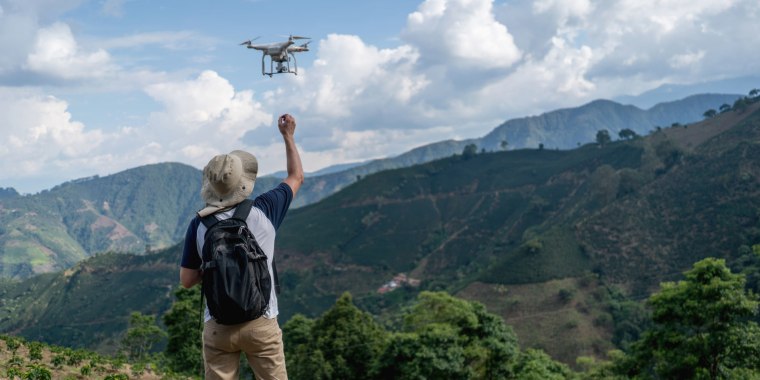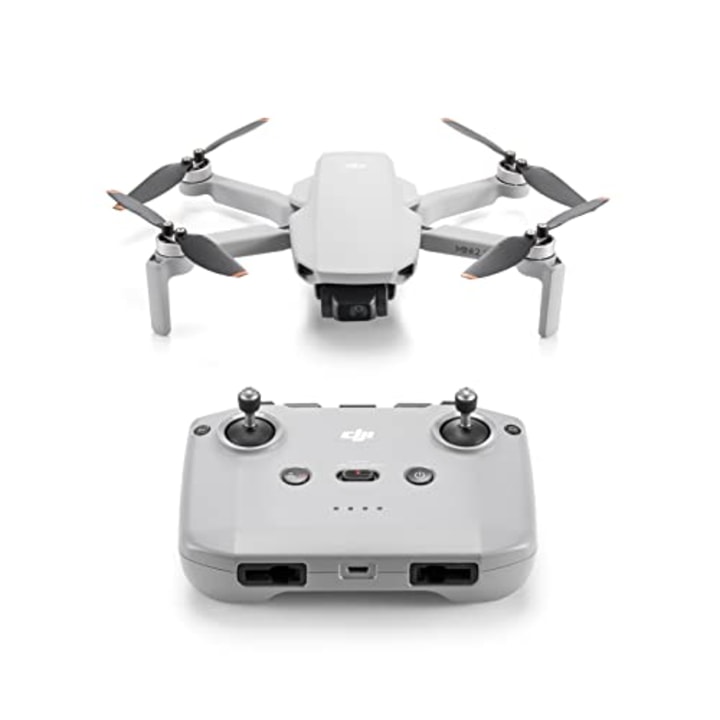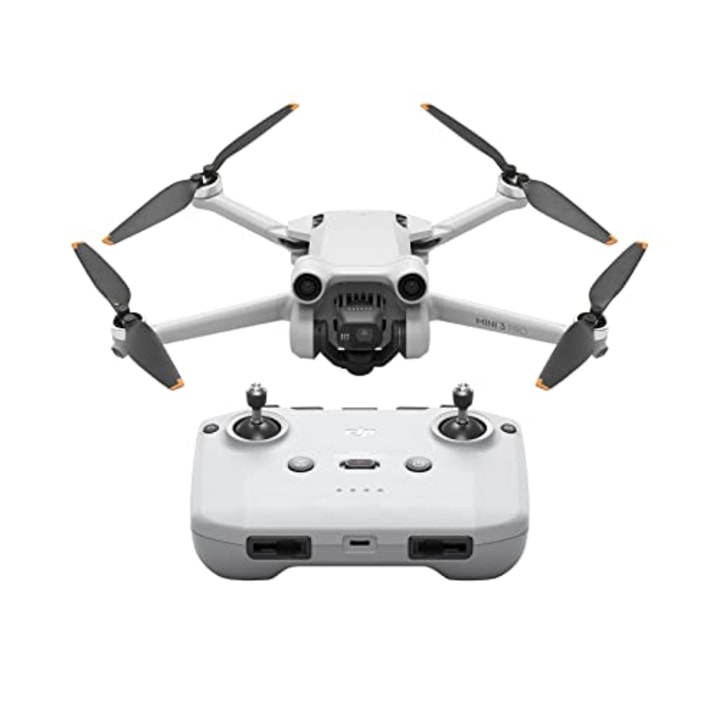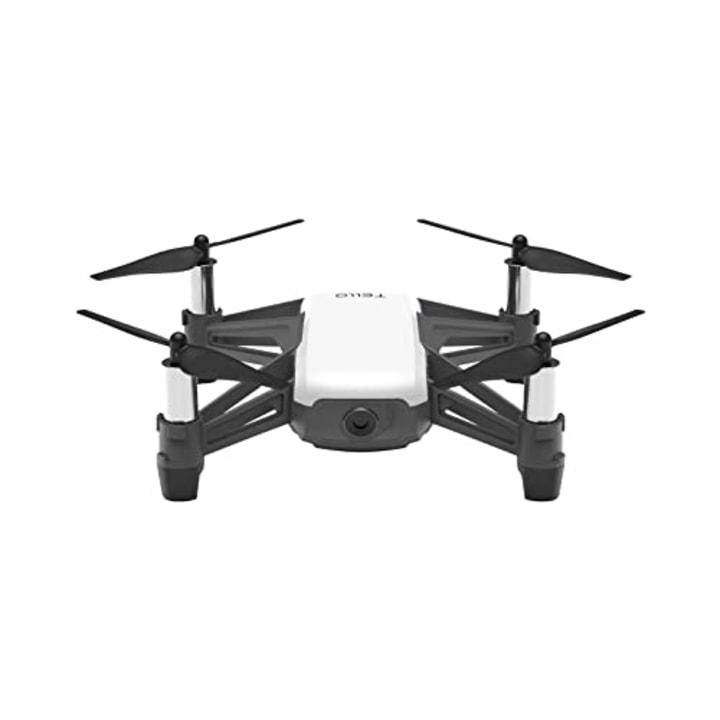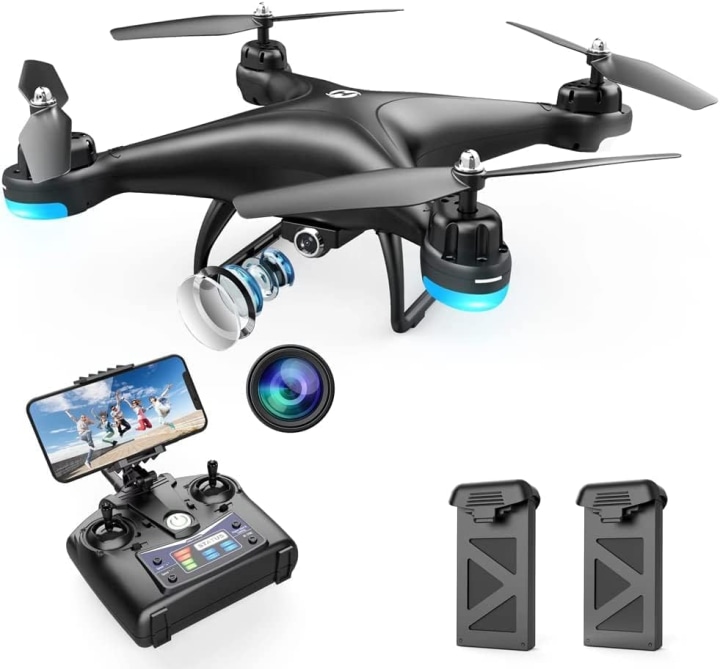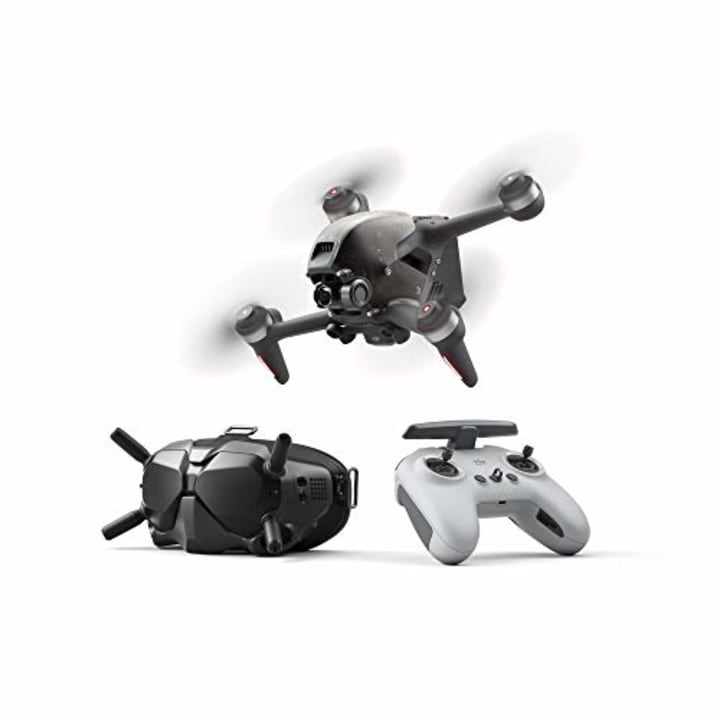Have you ever been somewhere scenic and wished you could capture a picture or video of all your surroundings to share with friends and family? How about getting field-wide footage of recreational sports? A drone can shoot these memorable moments, capturing photos and videos from high up in the air.
Drones are used for photography, videography, grocery delivery, surveillance and even speed racing. They come in many different models ranging from $100 to well over $1000. To help find the best drones for beginners, we consulted experts on the different options, what features to look for and tips for flying safely and legally.
SKIP AHEAD The best beginner drones in 2023 | How to shop for a beginner drone | What to do before flying a drone | Your first flight
Our top picks
- Top pick: DJI Mini 2 SE
- Splurge pick: DJI Mini 3 Pro
- Most affordable toy drone: Holy Stone HS110D
What is a drone?
The US Federal Aviation Administration (FAA) calls any small, unmanned aircraft system a drone. Consumer drones are typically propeller-powered quad-copters with a camera or camera system in the center. They are most commonly used for photography and filmmaking, but are also useful in industries that work in large outdoor spaces like construction and public safety, says Alan Perlman, founder and lead course instructor of UAV Coach, a drone training group and program that has trained over 50,000 recreational and corporate pilots.
How we picked the best drones
We spoke to industry experts to better understand the different types of drones and beginner-friendly options. Using their guidance, we selected top-rated drones with a four-star average rating based on the following criteria:
- Category: Our experts listed three categories of drones: toy, consumer or professional and first-person view (FPV) (more on these categories below). We selected top-rated options from all three categories.
- Price: High-end drones for professionals can cost over $1500, according to our experts. We highlighted drones between $100 and $1000, as they are capable for beginners with different needs and intentions.
The best beginner drones in 2023
Following our experts’ guidance and market research, our top picks largely came from DJI. DJI is a leading brand in consumer drones, and accounts for over 70% of the global drone market, according to a 2023 report by Drone Industry Insights. Our recommendations for toy drones come from smaller brands with thousands of positive online reviews like Ryze and Holy Stone.
Below each recommendation, we share specifications we think you should know, like weight, max flight time (battery life), communication range and video resolution.
Top pick: DJI Mini 2 SE
This consumer drone is one of DJI’s lowest priced but shares many of the features of its more expensive models: namely battery life, speed and range. It has a max flight time of 31 minutes — triple most toy drones — and only 3 minutes less than the much pricier DJI Mini 3 Pro. You can communicate with this drone from up to 10 kilometers away (without obstructions), more than enough distance to capture wide landscape shots or ocean views. Most toy drones, by comparison, can only be controlled up to 100 meters away.
The camera system captures photos in 4K and videos in quad-HD (1440p). It does however have a narrower range of motion for tilting, rolling and panning the camera compared to more expensive DJI drones. That said, it is still one of DJI’s highest rated drones with a 4.6 star average rating from over 5,000 reviewers on Amazon.
To fly, mount a smartphone to the included DJI controller and use the DJI Fly app. The joysticks on the controller let you move the drone while your phone shows a live view from the drone’s camera, plus a few camera controls.
The drone’s battery and remote controller are USB-C rechargeable. Photos and videos are saved to the microSD card (sold separately) inside the drone.
Weight: 246g | Dimensions: 138x81x58mm folded, 245x289x56mm unfolded with propellers | Max flight time: 31 minutes | Max takeoff altitude: 4000 meters | Max speed (horizontal): 57.6 kph | Obstacle detection: Downward | Controller: Included, smartphone mounts on | Communication Range (unobstructed): 10km | Photo resolution: 4000x3000 (12mp lens) | Video resolution: 2720x1530 at up to 30FPS, 1080p at up to 60FPS | Aperture: f/2.8 | Field of view: 83 degrees | Vertical shooting: No
Splurge pick: DJI Mini 3 Pro
This small and portable consumer drone has more advanced camera and piloting features than similarly-sized options (like the DJI Mini 2 SE and DJI Mini 3) under $1000. It has the highest resolution lens of our recommendations at 48 megapixels, which allows you to capture more details in both photo and video. It can shoot 4K photos and videos at a high frame rate, letting you easily capture and create slow-motion video. The drone can also take shots in both horizontal and vertical orientations, unlike the other drones on our list. It also has forward, backward and downward obstacle detection — the most of any of DJI’s small-sized drones.
Like other DJI drones, it can be controlled using the included DJI controller, your smartphone and the DJI Fly app. Similar to the Mini 2 SE, the Mini 3 Pro has a 4.5 star average rating from over 1,000 reviewers on Amazon. The drone’s battery and remote control are USB-C rechargeable, and photos and videos are saved to the microSD card (sold separately) inside the drone.
Weight: Under 249g | Dimensions: 145x90x62mm folded, 251x362x70mm unfolded with propellers | Max flight time: 34 minutes | Max takeoff altitude: 4000 meters | Max speed (horizontal): 57.6 kph | Obstacle detection: Forward, backward, downward | Controller: Included, smartphone mounts on | Communication Range (unobstructed): 12km | Photo resolution: 8064x6048 (48mp lens) | Video resolution: 3840x2160 at up to 60 FPS, 1080p at up to 120FPS | Aperture: f/1.7 | Field of view: 82.1 degrees | Vertical shooting: Yes
Top-rated toy drone: Ryze Tello
At $100, this toy drone from Ryze (owned by DJI) is an affordable alternative to DJI’s consumer and professional drones. It is also the smallest and lightest of our recommendations at just 80 grams, making it well-suited to travel — It also has a 4.2 star rating from over 3,700 reviewers on Amazon. The drone has a 5-megapixel lens that can take quad-HD photos, higher than most other toy drones at this price. Its video capabilities are limited to a lower 720p (HD) resolution, however.
Like most other toy drones, the Ryze Tello does not have obstacle detection, and can only be operated from about 100 meters away. It does have multiple flight modes though, including a flip mode where the drone will perform flips and a throw mode, where the drone will take off automatically when you gently throw it into the air, according to the brand.
This drone is controlled with a smartphone through the Ryze Tello app — there is no separate controller. The drone is micro-USB rechargeable, and photos and videos are saved directly to your smartphone.
Weight: 80g | Dimensions: 98x92.5x41mm | Max flight time: 13 minutes | Max takeoff altitude: Not listed | Max speed (horizontal): 28.8 kph | Obstacle detection: No | Controller: Smartphone | Communication Range (unobstructed): 100 meters | Photo resolution: 2592x1936 (5mp lens) | Video resolution: 720p at up to 30FPS | Aperture: Unlisted | Field of view: 82.6 degrees | Vertical shooting: No
Most affordable toy drone: Holy Stone HS110D
The Holy Stone HS110D is larger than our other toy drone recommendation but takes wider-angled, full HD (1080p) video. It has the shortest flight time at 10 minutes but comes with two swappable batteries included. It also has the most reviews of all the drones on our list, with a 4.2 star average rating from over 18,000 reviewers on Amazon.
The Holy Stone HS110D is controlled via the included remote controller, your smartphone (mounted to the controller) and the Holy Stone app. The drone is micro-USB rechargeable, while the remote control requires 4 AA batteries (not included) to power. Photos and videos are saved to the microSD card (sold separately) inside the drone.
Weight: 149g | Dimensions: 322x322x91mm | Max flight time: 10 minutes | Max takeoff altitude: Not listed | Max speed (horizontal): Not listed | Obstacle detection: No | Controller: Included, smartphone mounts on | Communication Range (unobstructed): 100 meters | Photo resolution: 1920x1080 (lens not listed) | Video resolution: 1080p, FPS not listed | Aperture: f/2.8 | Field of view: 120 degrees | Vertical shooting: No
For first-person view: DJI FPV
First-person view (FPV) drones are very different from consumer or toy drones — they are designed for a fast, skillful and manual flight experience with less automatic stabilization. FPV drones are used by skilled pilots for racing leagues, large outdoor events and creative fly-throughs of buildings, according to our experts.
The DJI FPV has a max speed of 140kph — that is well over double the DJI Mini 3 Pro’s max speed of 57.6kph. It also has the highest takeoff altitude of all of our picks at 6000 meters. To pilot, you use a controller to move the drone and wear goggles that show the drone’s view, similar to wearing a VR headset. Like the DJI Mini 3 Pro, the DJI FPV’s camera can capture 4K photos and videos at high frame rates, although it can only capture in horizontal, not vertical, orientation. With a 120-degree field of view, it can capture wider shots than most of our recommendations.
The DJI FPV is much larger and heavier and only has a 20-minute flight time, compared to other consumer options on this list. That said, it’s one of the best options for beginners interested in an FPV drone — it has a 4.4 star average rating from over 1,000 reviewers on Amazon. The drone’s battery and remote controller are USB-C rechargeable, and photos and videos are saved to the microSD card (sold separately) inside the drone.
Weight: 795g | Dimensions: 178x232x127mm without propellers, 255x312x127mm with propellers | Max flight time: 20 minutes | Max takeoff altitude: 6000 meters | Max speed (horizontal): 140kph meter per second | Obstacle detection: Forward, downward | Controller: DJI FPV Goggles and remote controller | Communication Range (unobstructed): 10km | Photo resolution: 3840x2160 (12mp lens) | Video resolution: 3840x2160 at up to 60 FPS, 1080p at up to 120FPS | Aperture: f/2.8 | Field of view: 120 degrees | Vertical shooting: No
How to shop for a beginner drone
There are two main categories of drones: toy drones and consumer or professional drones, says Perlman.
Toy drones range from $50 to $200 and are great as training drones or gifts for children, says Perlman. These drones are lower priced but have a short battery life, lower resolution cameras and are generally less stable in the air.
Consumer and professional drones range from around $300 to $3,000 and are appropriate for hobbyists and professionals, depending on cost. They have a much longer battery life, better cameras, more sophisticated flight software and offer a more stable flying experience, says Perlman. FPV drones fall under this category.
What kind of drone you should buy depends on your goals, says John Moore, Getty Images special correspondent and Pulitzer prize-winning photographer who has used drones to document the US-Mexico border and the war in Ukraine. If you are trying to capture quality photos and videos, look for drones that can capture 4K footage at a high frame rate, allowing you to get detailed imagery very rapidly, reducing the chance of missing a split-second moment like a fast-moving person or object.
Also, look for a drone that shoots with a RAW file format, says Moore. Professionals prefer the RAW file format as it does not compress or degrade photos and video like other file formats do.
If you are more interested in the experience of flying rather than photography, an FPV drone could be for you. FPV drones typically take slightly less detailed photos and videos than consumer or professional drones. That said, they can offer a more immersive flying experience since FPV goggles worn when piloting bring the drone’s view directly to your eyes. FPV drones are also much faster and more agile than other drones.
What to consider before flying a drone
Whether you are a new pilot or have many years of aviation experience, rules and safety tips exist to help you fly safely in the National Airspace System (NAS), says Rick Breitenfeldt, a public affairs specialist at the Federal Aviation Administration (FAA). Here are a few things you should do before flying a drone, according to Breitenfeldt and the FAA:
Determine if you are a recreational flyer or a commercial flyer
There are different rules and regulations you must follow depending on what type of flyer you are.
Recreational flyers fly for purely recreational purposes (personal enjoyment). All recreational flyers must follow the Exception for Limited Recreational Operations of Unmanned Aircraft (USC 44809) rules, outlined here, and pass the The Recreational UAS Safety Test (TRUST) online. (The test is free.) You must carry proof of test passage wherever you fly your drone.
Commercial flyers fly in a manner that could promote or further a business (regardless of any revenue earned). All commercial flyers must follow rules outlined in Part 107, including registering for and passing the Part 107 aeronautical knowledge test at an in-person testing center. (There is a testing fee of $175.) Some examples of commercial flyers include sports photographers, social media influencers or real estate companies.
If you are still unsure what type of flyer you are, the determining factor is your intent, says Breitenfeldt.
Register your drone
All types of flyers can register their drone online at FAADroneZone. Recreational flyers register under the Exception for Limited Recreational Operations, while commercial flyers register under Part 107. Both forms of registration cost $5 and are valid for three years. Wherever you fly, carry proof of your FAA registration with you, and mark the outside of your drone with your registration number.
The only exception in which you do not need to register your drone is if you are a recreational flyer using a drone that weighs less than 250 grams. Though it can’t hurt to register anyway, says Breitenfeldt.
Find somewhere safe (and legal) to fly
Pilots must follow local, state and federal regulations on where it is legal to fly. The FAA recommends using its B4UFLY website and app. Commonly restricted airspace includes areas near airports, stadiums, sporting events, security-sensitive areas, restricted or special use airspace. Drones are also not permitted near emergency or rescue operations, including natural disasters like wildfires or hurricanes.
Your first flight
With your TRUST or Part 107 passed, registration filed and location sorted, you can fly your drone safely and legally. When flying for the first time, our experts recommend going to a wide open area with few people and buildings.
Start low to the ground, around 10 to 15 feet up in the air, says Perlman. Try making circular and boxed-shaped movements to help understand the controls. Many models also come with intelligent flight modes that can help with beginner learning. Reading the user manual and getting comfortable with the drone software can help too.
If you get into a crash, the propellers are most likely to break, but they’re cheap and easy to replace, says Perlman.
For taking great photos and videos, remember that it is not always better for your drone to be further away from your subject, says Moore. “Beginners tend to shoot too wide,” he says. “What you put in the frame of your camera should be what you want to see.”
Meet our experts
At Select, we work with experts who have specialized knowledge and authority based on relevant training and/or experience. We also take steps to ensure all expert advice and recommendations are made independently and without undisclosed financial conflicts of interest.
- Alan Perlman is the founder and lead course instructor of UAV Coach, a drone training group and program that has trained over 50,000 recreational and corporate pilots.
- John Moore is a Getty Images special correspondent and Pulitzer prize-winning photographer who has used drones to document the US-Mexico border and the war in Ukraine.
- Rick Breitenfeldt is a public affairs specialist at the Federal Aviation Administration (FAA).
Why trust Select?
Harry Rabinowitz is a reporter for Select who has covered tech for years, including articles on earbuds, keyboards and fitness trackers. For this piece, he spoke with drone experts for beginner tips and flying guidance. He also researched top-rated models that fell in line with our experts’ guidance.
Catch up on Select’s in-depth coverage of personal finance, tech and tools, wellness and more, and follow us on Facebook, Instagram, Twitter and TikTok to stay up to date.
